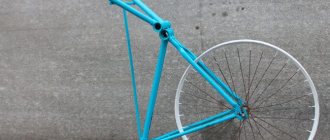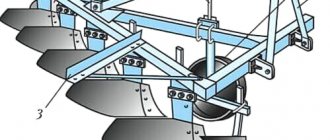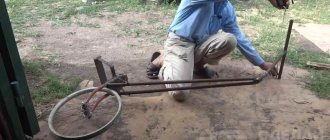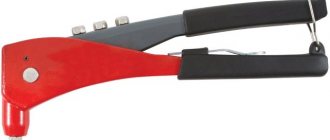why a manual cultivator today. To facilitate the cultivation of a plot of land, summer residents purchase various agricultural equipment - irrigation, sowing, harvesting, and soil care. The latter is the most labor-intensive and quite complex process, because it is necessary to harrow, loosen and dig up the soil. a hand cultivator for the garden can help you with this .
It will be useful in cultivating land on a small plot; it will help cultivate the land faster, more efficiently and with better quality.
There is a wide variety of cultivators available on agricultural machinery markets. Experienced gardeners and gardeners carefully select and purchase the much-needed tool.
To choose the right cultivator, you need to determine how often the equipment will be used and for what purposes. Let's compare the types of hand cultivators available on the market, their advantages and disadvantages.
Manual soil cultivator. What it is?
A manual cultivator is a modern, effective mechanical assistant that helps prepare the land for various types of agricultural work.
Using the device, you can not only prepare the soil for the spring sowing campaign, but also thoroughly mix fertilizers and normalize the structure of the soil. The main working part is cutters that are in direct contact with fertile soil layers. Advantages: low price range, convenience, ease of use.
A miracle shovel for digging soil - a well-groomed garden without effort! Author of the article. Kuznetsov Vasily Stepanovich.
Main functions:
- weeding;
- plowing;
- weed removal;
- loosening the soil;
- formation of planting holes;
- mixing soil and applied mineral and organic fertilizers.
Manufacturers produce several types of this device:
- rotary;
- ripper;
- electric;
- petrol;
- diesel.
Before purchasing a cultivator, you need to know the volume of planned work and the number of cultivated areas. For home use in small garden plots, there is no need to buy expensive equipment, but rather opt for simple and small models with an affordable price range.
Depending on the weight, three types of devices can be distinguished.
- Lungs. They are used for areas with light soil with an area of no more than 10 acres. The router penetrates no more than 25 cm in depth. The device is widely used in greenhouses and greenhouses. The use of an electrically driven device significantly limits the cultivation area.
- Average. Devices for processing areas with different types of soil up to 30 acres. The maximum weight of one device can reach 40 kg. To carry out the work, you must have experience in operating agricultural machinery.
- Heavy. Devices with a weight of up to 65 kg and a working area of up to 50 acres. Universal and mobile devices operate only on combustible fuel.
Types of attachments
If you want to make your cultivator truly multifunctional, we recommend installing additional attachments on it. This equipment allows you to perform not only standard types of work such as plowing or loosening: with certain types of attachments you can hill up the soil, plant and harvest potatoes, cut furrows, and sow seeds. Some attachments are designed for tasks such as making hay, removing debris and snow. The use of attachments will save a lot of money, because you do not have to purchase separate equipment for various types of agricultural work.
Hinges can be divided into two types: active and passive. Active ones have moving parts that begin to work using the cultivator engine. The rotational energy of the engine is transferred to the linkage either with a belt drive or through a special power take-off shaft. Active type attachments include a snow blower, different types of mowers, and a sweeping brush. Passive attachments are not equipped with their own moving parts and are activated only by the movement of the cultivator itself. The most popular attachments of this type are a plow, a hiller, a potato planter, and a potato digger.
Let's look at the most useful and popular types of attachments among farmers.
Hitch
This is an auxiliary adapter element that allows you to attach any attachment to the cultivator. Without a hitch, you are unlikely to be able to install a plow or hiller.
Advice! As a rule, each specific model has its own individual coupling mechanism. It is therefore recommended that the operating parts of the hitch and the hitch be manufactured by the same manufacturer.
There are both universal hitches and hitches manufactured for a specific brand. Typically, the towbar is installed at one time using mounting brackets. Removing it is much easier; it is not necessary to use additional tools.
Hiller
An experienced farmer rarely does his work without it. The equipment facilitates hilling the soil, forms smooth ridges and an earthen ridge. Most often, the cultivator is equipped with a special hiller for potatoes. It is used for cutting even furrows and digging up root crops during the harvest period. There are hillers with dump plowshares (steel sheets) and disk hillers of the propeller type. Today, disc hillers are most in demand in agriculture; most modern manufacturers produce them. When performing its functions, this type of hiller encounters much less resistance from the ground. As a result, the load on the equipment and the lead operator is reduced. By adjusting the settings when installing the disc hiller, you can form earth ridges of different heights. At the same time, the earthen ridges are stronger and more stable than those of hillers with ploughshares. When creating a ridge, the latter pour part of the earth back into the furrow.
Disc hiller for cultivator
Plow
They are used for virgin soil during plowing, when it is necessary to turn over large layers of earth. The hitch is installed via a hitch or a special adapter. Nowadays, summer residents use one of two types of plows: standard and reversible. A conventional plow forms a moldboard in only one direction during operation. The reverse one, in turn, consists of two plows, therefore, soil dumps are carried out on two sides at once. With the help of the second type of plow, you can plow a large area of the site much faster and more efficiently.
Reversible plow
Potato planter
Purchasing this attachment will save you from the tedious and time-consuming procedure of planting potatoes. The planter is a complex unit consisting of a small plow, a hopper with a transport belt and a disc hiller. The plow forms a trench and prepares the soil for planting root crops. Seed material for planting is loaded onto the transport belt. The compact hiller loosens the soil and sprinkles the planted material.
This equipment is productive, but expensive. However, the potato planter fully justifies its price when cultivating a large number of hectares of land.
Potato digger
The main task of the hitch is to collect the finished crop. The design is similar to a hiller, but instead of steel blades it has long arms reminiscent of a broom. The principle of operation is simple: the rays dig up the surface of the soil, the soil is thoroughly sifted, and the pulled out root crops are automatically thrown in the other direction. The attachment is fastened to the cultivator via a hitch.
Grain planter
As the name suggests, this attachment is used for planting seeds. Available in two variations: 2-row planter and 4-row. The hitch is a complex consisting of a hopper for seed material, a calibration disk, and a small plow for cutting furrows. To prevent the planter from slipping, a steel lug is installed in the rear part of it.
How to use a hand cultivator. Operating principle
Cultivators for manual tillage are divided into two groups: rippers and rotary models. Representatives of the first variety are shaped like a hand equipped with three or five metal “fingers.”
Cultivator for the garden
In essence, this is a highly modernized hoe, which requires a lot of physical effort to operate. Therefore, this option is more suitable for working in greenhouses. The working element of rotational models is made in the form of stars, with a large number of rays.
During operation, the stars literally “bite” into the ground, loosening the soil and at the same time cutting and crushing weeds.
How to use a rotary cultivator with stars? Due to the simplicity of the design, this device is quite easy to handle.
The unit is installed vertically in the ground, the standard position of the cultivator: the stars are located between the rows, the connecting axis passes over the bed. The cultivator is driven by applied forces.
Even taking into account the fact that the driving force is a person, cultivating the land is much faster than when performing similar actions with a shovel or hoe.
Almost all models of manual rotary cultivators are equipped with additional wheels, which makes it easier to move the unit around the beds. In addition, the product can be attached to a long handle, which allows you to work without bending your back.
This point is very important for pensioners who often suffer from radiculitis; in fact, they are the main buyers of this type of gardening equipment.
Tornado hand cultivator. The lineup
Usually, any work in the country or in a personal plot has not very pleasant components - fatigue, pain in the back, legs, arms. Therefore, users perceive every new product and improvement, such as the Fokin and Kozma flat cutters and the Tornado cultivator, with great enthusiasm.
The first cultivator, instead of today's universal arc, had comfortable hand grips and looked like this in the photo:
The Tornado hand cultivator has a simple device - it is a durable metal rod with a curved crossbar on top and control handles. Specially curved, sharpened teeth are fixed at the bottom of the device. Without much physical effort, performing short sharp rotations clockwise, a person can easily control the convenient device.
Manual cultivator root remover
The root remover has a wide range of capabilities - loosening the soil, digging, removing weeds, weeding, delicate cultivation of the soil near trees and bushes with a productivity 3-4 times higher than when working with simple tools.
Manual cultivator root remover
The depth of tillage is up to 20 cm, that is, almost the length of a shovel. Unlike the Fokin flat cutter, which, in fact, is just a slightly modified hoe, the Tornado cultivator can comfortably perform all the specified work without bending over.
At the same time, the layers of earth do not turn over, but retain their natural position with their characteristic microflora. Also, the seeds of preserved perennial weeds are not pulled out from the depths to the surface, as with deep plowing.
Root remover
A lightweight, ergonomic tool with which you can quickly and conveniently, with pinpoint precision, dig up an area, loosen the soil, and make holes for planting seedlings. The weight of the equipment is only 0.5 kg.
Cultivator weed extractor
A modernized version of the Tornado-mini cultivator, with which you can also loosen the soil, make holes for bulbous plants, and weed rows. Thanks to the adjustment, the cultivator can be adjusted to the individual height of the worker.
Manual potato digger
The specialized manual potato digger is easily adjustable in height and does not put any strain on the operator’s lower back.
Manual potato digger Tornado
The sharp teeth of the cultivator are made by hand forging from durable steel. This is a truly universal tool - having acquired certain skills, you can do many other jobs with it - loosening, preparing holes for planting.
Garden drill Tornado-Profi
Designed for preparing holes when planting various plants, applying fertilizers and water under trees. Thanks to the manual production of the forged part of the drill, the product is highly reliable and durable.
Garden drill Tornado-Profi
The drilling diameter is 20 cm, the depth can reach 1.5 m, thanks to which the Tornado drill can be used for other economic purposes, in the construction of fences.
Superbur
The product is distinguished by the material of manufacture – high-strength steel that has undergone heat treatment. Forged teeth with a characteristic geometry pass through any soil without interference, even with stones and other objects.
Shovel
The ergonomic Tornado shovel with a special grip allows you to perform heavy work with sand, earth, crushed stone, and clay without putting stress on the spine. The efficiency and performance compared to a conventional shovel are not comparable.
Scoop shovel Tornado
Winter shovel
The super-strong shovel is made of frost-resistant metal and has impressive dimensions of 40x40 cm. Thanks to the special curved shape of the shovel, both hands comfortably hold the tool while working, relieving the lower back of the load. The weight of the model is only 1.6 kg.
Miracle shovel
The shovel is an improved version of the popular Plowman shovel. This product is distinguished by its reduced weight (4 kg), optimal processing parameters - width 35 cm, depth 25 cm. The shovel has sharp forged teeth, all metal elements are coated with a special composite varnish, which prevents soil from sticking.
A hoe instead of a shovel?
Some summer residents who are supporters of “ecological farming” refuse to dig up the beds every year, replacing it with loosening with a flat cutter or similar tool. In what cases is this justified?
1. The soil in your garden is not too heavy. On floating clays, plant roots suffer from lack of air, so deep digging is necessary every year.
2. You annually add a large amount of organic matter to the beds and do not abuse “chemistry”. Only soil with a high humus content and good activity of soil microorganisms and earthworms can independently maintain a loose, root-permeable structure.
3. There are no perennial weeds (wheatgrass, wheatgrass, sow thistle, etc.) and horseradish. Rhizomes cut into pieces spread at triple speed!
Do-it-yourself tornado hand cultivator. About the device
In the fields, cultivation is carried out using special equipment with the necessary equipment, but as for small farms and plots, for their cultivation you can use light motorized equipment, such as cultivators such as an electric cultivator for a summer residence, a mini cultivator, Loplosh or manual cultivators.
If we talk about a homemade manual cultivator for the garden with your own hands, it is quite possible to make it.
It can be made without the use of any special materials or tools, and this can be done in a day or a couple of hours, depending on what exactly the future product will be - a simple hedgehog with a handle, or a modification of an old bicycle.
But you will definitely get benefits from such a product. It will be a well-kept garden, where a variety of crops bear fruit equally well, free of weeds, with soil that is easy to cultivate.
Such products operate solely with the help of muscle power, so there will be no costs for electricity and fuel, especially engine maintenance and replacement of parts.
All mechanical parts are extremely reliable due to their simplicity, and if they break down, it will be very easy to replace anything - you just need to make a new part from existing materials.
Also, the manufacture of homemade hand cultivators requires virtually no design or engineering experience, since they consist mainly of just a few movable joints.
Manual cultivator for weeding. Types of manual cultivators
Using a hand cultivator is necessary if you need to cultivate flower beds, greenhouses, alpine hills, and areas between bushes and trees at your dacha. The intended purpose of the device is for the garden and for indoor plants. Depending on the design features, the following options are distinguished:
- rotary;
- ripper;
- root remover;
- potato digger;
- flat cutter
Hand cultivator at work
Manual garden cultivators have many advantages. These include:
- ease of use;
- affordable price;
- small dimensions;
- light weight;
- no need for maintenance, i.e. lubrication, refueling;
- careful cutting of weeds;
- the ability to treat hard-to-reach and delicate places in the country;
- a wide range of work performed;
- higher level of safety compared to motorized and electrical appliances.
Manual units for dachas are not without their drawbacks. Their disadvantages are:
- low productivity, so they are not suitable for performing tasks over large areas;
- obsolescence compared to modern self-propelled units;
- the need to replace disks in rotary structures;
- low efficiency on hard soils, virgin soil;
- the need to use physical force, so processing the area may require a lot of labor.
Rotary
Rotary cultivator
In another way, such a soil ripper is called a star ripper. It operates via a small shaft with sprocket discs. The soil is captured by the sharp teeth of the cutting mechanism, after which it is lifted and turned out. This is how digging and weeding occurs at the same time. Additionally, the cultivator is equipped with an adjustable handle. The star design is convenient for processing in hard-to-reach places. Often the kit includes a weed blade attachment.
Ripper
Cultivator-ripper
This version of the manual cultivator is devoid of any mechanisms. The end of the device is supplemented with 3-5 teeth with flat plates. They can cut deep into the soil. To loosen the soil, you need to pull the cultivator towards you. If you lower the structure with force, you can break through the dense crust that occurs after heavy rainfall or compaction. The ripper can be a regular size for a garden or a miniature one with a short handle for indoor plants.
Root remover
Cultivator-horse remover
It looks like a pole with spirally curved and elongated fingers-teeth at the end. With this cultivator you can accurately and quickly remove the roots of weeds and other unnecessary plants on the site. It is also suitable for loosening the soil and digging holes in it for seedlings. Moreover, this type of device will not damage the soil structure by mixing the fertile composition. With its help you can give the site a beautiful and well-groomed look.
Potato digger
Potato digger
Traditionally, villagers use pitchforks to dig up potatoes. A slight modification of their design turns such a tool into a simple but convenient hand-held cultivator. His forks are bent at an angle of 30-50 degrees to the ground, and instead of a handle, a metal pipe with a horizontal handle is used. Potatoes are dug up by sticking the cultivator into the soil near the bush, turning it around its axis and tilting the handle until the potatoes are removed.
Flat cutter
Manual flat cutter
With the help of such a cultivator you can cut off the roots of weeds and loosen them. This device does not turn over the top layer, due to which the structure of the soil is not disturbed, but the yield increases. A manual flat cutter is several sharpened flat knives or peaks that are attached to vertical reinforcement rods. When moving, peaks or knives can go to a depth of 10-20 cm, cutting off the upper layer.
Ripper Fokina
This garden tool is called the Fokin flat cutter, named after its inventor. It is designed for loosening the soil and weeding it. Using the equipment, you can do twenty different types of work in the garden. The main function of the flat cutter is to pull out or cut weeds at a depth of two to five centimeters. This method of tillage is gentle because the structure of the soil does not change, it does not harm animals and insects, and it does not require a lot of physical effort and time.
Loosening is carried out without wrapping the soil layer, so there is no need to change the surface layer. Of course, it is impossible to plow the soil to great depths with a flat cutter. In traditional farming, he rather plays the role of a chopper. But, if the soil is porous and has a mulch layer, Fokina garden tools for loosening the soil can work wonders. Its design is very simple. Two plates, bent at a certain angle, resemble staples. The surfaces used to cut weeds are sharpened sharply.
Fokin flat cutters have six varieties, each of which is designed for a specific job on a plot of land. For example, with a small tool, beds are weeded and dense shoots are thinned out. With the help of large equipment, the preparation, formation and hilling of beds is carried out. They also mow the grass. It is better to loosen heavy clay soils with a “Krepysh” flat cutter with a shortened blade. For hilling tall plants, the “Moguschnik” is suitable - it has a wide blade.











